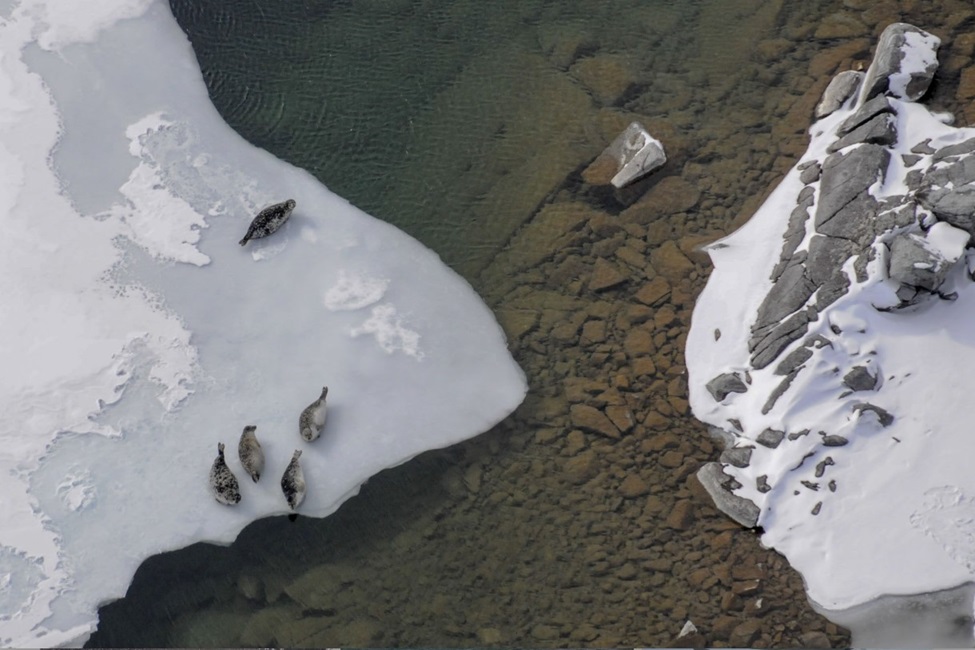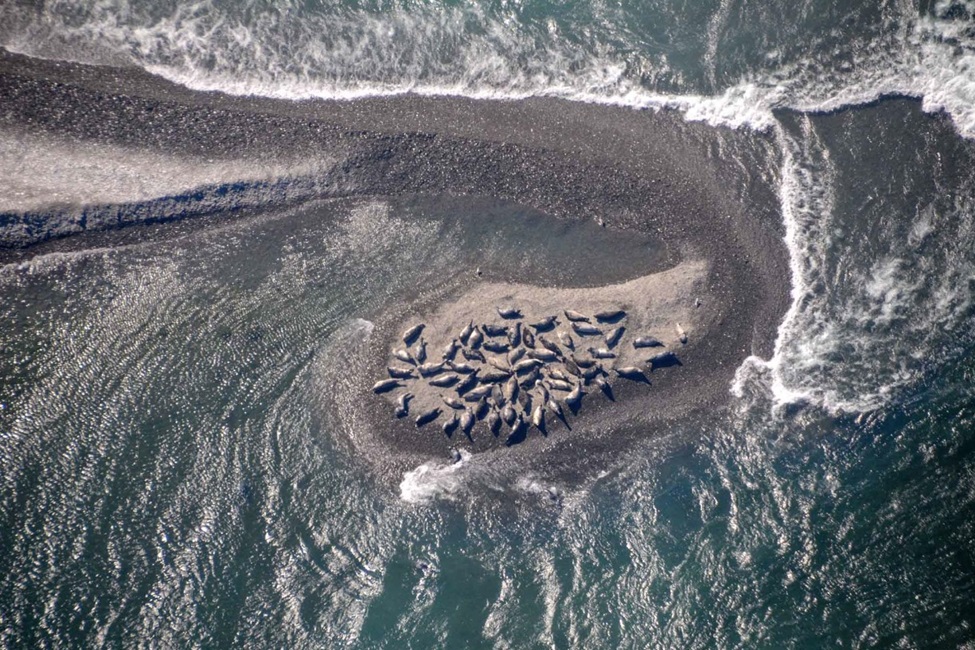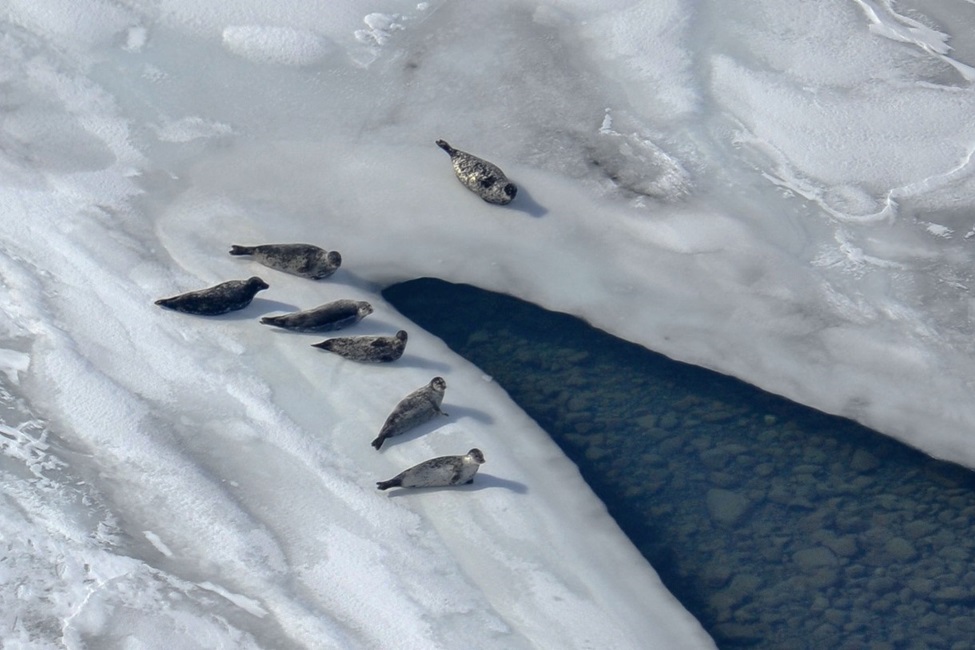Iliamna Lake Harbor Seals Genetically Isolated from Pacific Ocean

A closeup of a harbor seal in Alaska’s Iliamna Lake (Photo credit: Jason Ching)
There are only five seal populations worldwide that live year-round in freshwater habitats. The Baikal seal, probably the most well-known, lives in the deepest, oldest lake in the world, 1,600 kilometers from the ocean in Lake Baikal, central Siberia. However, perhaps the most enigmatic population of freshwater seals can be found a little closer to home in Alaska’s Iliamna Lake.
Despite their wider anonymity, the Iliamna seals have long been known to the Dena’ina Athabascan and Central Yupik peoples of southwestern Alaska, who have deep cultural and dietary ties to this small pinniped. Unlike other freshwater seal populations globally, the seals in Alaska’s largest lake have been largely overlooked by scientists. Their remote location and the difficulties in studying these elusive animals have contributed to this lack of attention. It wasn’t until 2013 that genetic research finally identified them as harbor seals.
A long-standing question has been whether the seals in Iliamna Lake were separate from those in Bristol Bay, the nearest marine population. The bay is connected to the lake by the 110 kilometer-long Kvichak River. Harbor seals commonly move more than 200 kilometers, and the relatively short distance between the lake and Bristol Bay, combined with sporadic sightings of seals in the river has led to the hypothesis that they move regularly between the freshwater and marine habitats.
A team of scientists, led by Florida Atlantic University, in partnership with local indigenous communities set out to find the answer. Researchers conducted a genetic study of seals in the lake and compared them to seals not only in Bristol Bay, but across almost the entire Pacific Ocean range of the species, from Japan to California.
Results of the study, published in the journal Biology Letters, reveal that the seals in Iliamna Lake are notably different at multiple genetic markers from the seals downstream. Findings indicate that they are likely evolutionarily, reproductively and demographically discrete from other seal populations in the Pacific and could be a unique endemic form of harbor seal.
The seals in Iliamna Lake were significantly differentiated from seals sampled at several regions across the Pacific, including in Japan, the Commander Islands in Russia, other locations in Alaska, and in California. They had lower levels of variation at the selectively neutral markers investigated, and somewhat higher estimates of inbreeding compared to the marine populations.
“Our findings are both striking and unexpected,” said Greg O’Corry Crowe, Ph.D., senior author, program lead, and a research professor at FAU Harbor Branch Oceanographic Institute. “Indigenous knowledge and early Russian explorers’ accounts suggest that the seals have been in Iliamna Lake for at least 200 years. However, it’s still uncertain whether they have been there for a longer period or if the observed differences might indicate that the Iliamna seals represent a separate subspecies, similar to other freshwater seal populations.”
The initial critical samples for this research came from subsistence hunters, providing early hints that seal movements between Iliamna Lake and Bristol Bay might be limited. However, the small sample sizes necessitated cautious interpretation of these preliminary results. With limited prospects for more samples, the research faced a standstill.
Progress resumed when a University of Washington team, including then-graduate student and co-author Donna Hauser, Ph.D., now a research associate professor at the University of Alaska Fairbanks, International Arctic Research Center, collected seal scat (feces samples) from various locations around Iliamna Lake in collaboration with co-author Thomas P. Quinn, Ph.D., a professor in the School of Aquatic and Fishery Sciences, University of Washington. This new batch of samples allowed for expanded genetic analysis and reinvigorated the study.
Collaborating with National Oceanic and Atmospheric Administration (NOAA) scientists, the FAU team processed hundreds of scat samples. Though extracting adequate DNA proved challenging, and many samples were unusable, the scat analysis yielded a four-fold increase in sample size and the statistical power needed for a more in-depth analysis.
“Excluding samples that don’t meet genetic screening standards can be disheartening, especially after investing so much time and effort,” said Tatiana Ferrer, first author and coordinator of research programs in the FAU Harbor Branch Wildlife and Behavior program. “Despite the frustration and long hours in the lab, the eventual success and valuable data make it all worthwhile. Hard work pays off when we achieve meaningful results.”
The FAU team and NOAA are planning more research on Iliamna seals, which will include more sampling and the addition of genomic analyses, to further resolve their relationships with other seal populations, and more broadly reveal how genetic diversity is generated, lost or maintained in small, isolated populations, and how typically marine species adapt to freshwater habitats.
“We can now confidently say there is a separate population of seals in the lake that receives no, or very few immigrants from the much larger marine harbor seal populations nearby,” said Peter Boveng, co-author and a research analyst at NOAA’s Alaska Fisheries Science Center. “I’m really excited for further studies to determine whether the lake seals differ from their marine counterparts in significant aspects of their ecology and evolution.”
Concern for Iliamna Lake, its flora and fauna, has increased recently with the growing interest in mineral exploration and development in the region.
“My fascination with Iliamna seals began during my undergraduate studies at the University of Washington, leading to my first research project on their diet and behavior. That work, published in 2008, was the only study on them for years,” said Hauser. “Revisiting Iliamna Lake in 2015 and 2017 with my family, I saw an opportunity to collect valuable samples on this unique seal population. I hope this research sparks further studies and encourages partnerships with local communities and Indigenous Knowledge holders.”
Detailed scientific data is needed to inform species management and conservation. The authors hope findings from this study could inform co-management of seals and assist NOAA, the federal agency responsible for harbor seal management in Alaska, and with decision-making.
“I have been curious about these seals since I first started working on Iliamna Lake in 1987, but never made any progress until Donna Hauser’s study of their diets over two decades ago,” said Quinn. “To see these remarkable genetic results, and the growing research connection to the local community, is simply marvelous. I am confident that there are more discoveries to come on the physiology and behavior of the seals as well as their evolution.”
Other study co-authors are David Withrow, a former research scientist at NOAA’s Alaska Fisheries Science Center; and Vladimir Burkanov, Ph.D., chief scientist at North Pacific Wildlife Consulting.
“This study has been a great leap forward in our understanding of these seals; however, more research is needed as it raised a whole new set of questions. That’s just the nature of science,” says O’Corry-Crowe. “We hope to work with the Iliamna and Bristol Bay communities to continue to address their questions, learn about these remarkable animals, and assist in ensuring the Iliamna Lake seal’s future.”

Alaska’s Iliamna Lake is home to one of the most enigmatic populations of freshwater seals (Photo credit: David Withrow, NOAA Fisheries)

Alaska’s Iliamna Lake harbor seals have been difficult to study because of their remoteness (Photo credit: David Withrow, NOAA Fisheries)

Alaska’s Iliamna Lake harbor seals commonly move more than 200 kilometers. Researchers hypothesized that they move regularly between freshwater and marine habitats. (Photo credit: David Withrow, NOAA Fisheries)
-FAU-
Latest News Desk
- FAU Named a National Center of Academic Excellence in Cyber ResearchFAU has been recognized as a National Center of Academic Excellence in Cyber Research by the National Security Agency and its partners in the National Centers of Academic Excellence in Cybersecurity.
- TBC Corporation Gift Expands Student Opportunities at FAUFAU's College of Business and TBC Corporation recently celebrated the naming of the TBC Corporation Study Room, recognizing a generous gift to support innovative college programs and activities for students.
- FAU Hosts 56th Annual Honors ConvocationFlorida Atlantic University President Adam Hasner and Interim Provost Russell Ivy recently hosted the 56th annual Honors Convocation.
- FAU Seeks Participants for Parkinson's, Aging and Mind-Body StudyFAU is recruiting participants for an exciting research study aimed at understanding the effects of Parkinson's disease and normal aging on cognitive performance, exercise ability and the mind-body connection.
- WHC Student Honored by Forum Club of the Palm BeachesEllie Pfahler, a student at Florida Atlantic University's Harriet L. Wilkes Honors College, is the inaugural recipient of the Forum Club of the Palm Beaches' Student Civic Engagement Award.
- Busted! Engineers Revolutionize Fraud Detection with Machine LearningA new breakthrough outperforms traditional methods by generating accurate fraud labels from large, imbalanced datasets, reducing cases needing further inspection, crucial for Medicare and credit card fraud.






